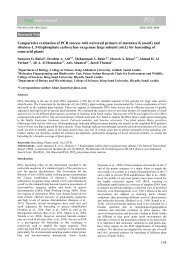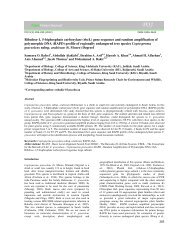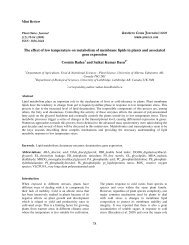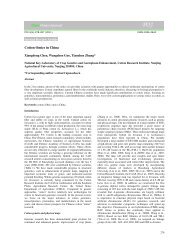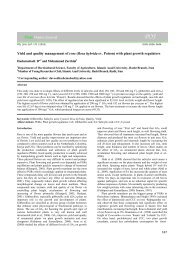Potential of Molecular Markers in Plant Biotechnology - ResearchGate
Potential of Molecular Markers in Plant Biotechnology - ResearchGate
Potential of Molecular Markers in Plant Biotechnology - ResearchGate
Create successful ePaper yourself
Turn your PDF publications into a flip-book with our unique Google optimized e-Paper software.
Review article<br />
provided the opportunity to develop a detailed genetic<br />
map <strong>of</strong> lettuce (Landry et al. 1987).<br />
Random Amplified Polymorphic DNA (RAPD)<br />
Introduction: RAPD is a PCR-based technology.<br />
The method is based on enzymatic amplification <strong>of</strong><br />
target or random DNA segments with arbitrary<br />
primers. In 1991 Welsh and McClelland developed a<br />
new PCR-based genetic assay namely randomly<br />
amplified polymorphic DNA (RAPD). This<br />
procedure detects nucleotide sequence<br />
polymorphisms <strong>in</strong> DNA by us<strong>in</strong>g a s<strong>in</strong>gle primer <strong>of</strong><br />
arbitrary nucleotide sequence. In this reaction, a<br />
s<strong>in</strong>gle species <strong>of</strong> primer anneals to the genomic DNA<br />
at two different sites on complementary strands <strong>of</strong><br />
DNA template. If these prim<strong>in</strong>g sites are with<strong>in</strong> an<br />
amplifiable range <strong>of</strong> each other, a discrete DNA<br />
product is formed through thermo cyclic<br />
amplification. On an average, each primer directs<br />
amplification <strong>of</strong> several discrete loci <strong>in</strong> the genome,<br />
mak<strong>in</strong>g the assay useful for efficient screen<strong>in</strong>g <strong>of</strong><br />
nucleotide sequence polymorphism between<br />
<strong>in</strong>dividuals (William et al.1993). However, due to the<br />
stoichastic nature <strong>of</strong> DNA amplification with random<br />
sequence primers, it is important to optimize and<br />
ma<strong>in</strong>ta<strong>in</strong> consistent reaction conditions for<br />
reproducible DNA amplification. RAPDs are DNA<br />
fragments amplified by the PCR us<strong>in</strong>g short synthetic<br />
primers (generally 10 bp) <strong>of</strong> random sequence. These<br />
oligonucleotides serve as both forward and reverse<br />
primer, and are usually able to amplify fragments<br />
from 1–10 genomic sites simultaneously. Amplified<br />
products (usually with<strong>in</strong> the 0.5–5 kb size range) are<br />
separated on agarose gels <strong>in</strong> the presence <strong>of</strong> ethidium<br />
bromide and view under ultraviolet light (Jones et al.<br />
1997) and presence and absence <strong>of</strong> band will be<br />
observed. These polymorphisms are considered to be<br />
primarily due to variation <strong>in</strong> the primer anneal<strong>in</strong>g<br />
sites, but they can also be generated by length<br />
differences <strong>in</strong> the amplified sequence between primer<br />
anneal<strong>in</strong>g sites. Each product is derived from a region<br />
<strong>of</strong> the genome that conta<strong>in</strong>s two short segments <strong>in</strong><br />
<strong>in</strong>verted orientation, on opposite strands that are<br />
complementary to the primer. Kesseli et al. (1994)<br />
compared the levels <strong>of</strong> polymorphism <strong>of</strong> two types <strong>of</strong><br />
molecular markers, RFLP and RAPDs, as detected<br />
between two cultivars <strong>of</strong> lettuce <strong>in</strong> the construction <strong>of</strong><br />
a genetic l<strong>in</strong>kage map. RFLP and RAPD markers<br />
showed similar distributions throughout the genome,<br />
both identified similar levels <strong>of</strong> polymorphism.<br />
RAPD loci, however, were identified more rapidly.<br />
Advantages: The ma<strong>in</strong> advantage <strong>of</strong> RAPDs is that<br />
they are quick and easy to assay. Because PCR is<br />
<strong>in</strong>volved, only low quantities <strong>of</strong> template DNA are<br />
required, usually 5–50 ng per reaction. S<strong>in</strong>ce random<br />
primers are commercially available, no sequence data<br />
for primer construction are needed. Moreover,<br />
RAPDs have a very high genomic abundance and are<br />
randomly distributed throughout the genome. They<br />
are dom<strong>in</strong>ant markers and hence have limitations <strong>in</strong><br />
their use as markers for mapp<strong>in</strong>g, which can be<br />
overcome to some extent by select<strong>in</strong>g those markers<br />
that are l<strong>in</strong>ked <strong>in</strong> coupl<strong>in</strong>g (Williams et al. 1993).<br />
RAPD assay has been used by several groups as<br />
efficient tools for identification <strong>of</strong> markers l<strong>in</strong>ked to<br />
agronomically important traits, which are<br />
<strong>in</strong>trogressed dur<strong>in</strong>g the development <strong>of</strong> near isogenic<br />
l<strong>in</strong>es.<br />
Disadvantages: The ma<strong>in</strong> drawback <strong>of</strong> RAPDs is<br />
their low reproducibility (Schierwater & Ender 1993),<br />
and hence highly standardized experimental<br />
procedures are needed because <strong>of</strong> their sensitivity to<br />
the reaction conditions. RAPD analyses generally<br />
require purified, high molecular weight DNA, and<br />
precautions are needed to avoid contam<strong>in</strong>ation <strong>of</strong><br />
DNA samples because short random primers are used<br />
that are able to amplify DNA fragments <strong>in</strong> a variety<br />
<strong>of</strong> organisms. Altogether, the <strong>in</strong>herent problems <strong>of</strong><br />
reproducibility make RAPDs unsuitable markers for<br />
transference or comparison <strong>of</strong> results among research<br />
teams work<strong>in</strong>g <strong>in</strong> a similar species and subject. As for<br />
most other multilocus techniques, RAPD markers are<br />
not locus-specific, band pr<strong>of</strong>iles cannot be <strong>in</strong>terpreted<br />
<strong>in</strong> terms <strong>of</strong> loci and alleles (dom<strong>in</strong>ance <strong>of</strong> markers),<br />
and similar sized fragments may not be homologous.<br />
RAPD markers were found to be easy to perform by<br />
different laboratories, but reproducibility was not<br />
achieved to a satisfactory level (Jones et al. 1997)<br />
and, therefore, the method was utilized less for<br />
rout<strong>in</strong>e identifications. RAPD marker diversity was<br />
used also applied for diversity studies with<strong>in</strong> and<br />
among some other Asteraceae species (Esselman et<br />
al. 2000).<br />
Applications: The application <strong>of</strong> RAPDs and their<br />
related modified markers <strong>in</strong> variability analysis and<br />
<strong>in</strong>dividual-specific genotyp<strong>in</strong>g has largely been<br />
carried out, but is less popular due to problems such<br />
145



